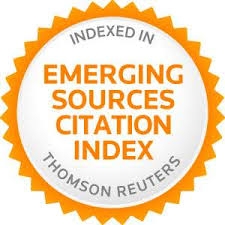Actitudes hacia la estadística en estudiantes de Ciencias de la Educación. Propiedades psicométicas de la versión española del Survey of Attitudes Toward Statistics (SATS-36)
Resumen
El estudio de las actitudes hacia la estadística es un tópico que ha suscitado el interés de investigadores en diferentes países y niveles de enseñanza. En el trabajo aquí presentado se expone un análisis de las propiedades psicométricas, en términos de validez estructural y consistencia interna, de la aplicación, en el contexto universitario nacional, del conocido Survey of Attitudes Toward Statistics (SATS), en su versión de 36 ítems. Los resultados obtenidos a partir de los 409 participantes, indican falta de ajuste para el modelo de seis factores propuestos por los autores del SATS, sobre todo, en comparación con el modelo de cinco factores con errores corregidos que proponen los autores de este trabajo. Estos resultados coinciden con lo defendido por otras investigaciones en cuanto a la reducción del número de componentes actitudinales medidos con el SATS
Palabras clave
Referencias
Anastasiadou, S. D. (2011). Reliability and validity testing of a new scale for measuring attitudes toward learning statistics with technology. Acta Didactica Napocensia, 4(1), 1–10.
Ashrafi, G. M., & Tariq, M. I. (2015). Investigating discrepancies in reliability coefficient of survey of students‘ attitudes towards statistics (SATS 36) for a Pakistani sample. International Interdisciplinary Journal of Education, 4(7), 201-225. doi: https://doi.org/10.12816/0025212
Auzmendi, E. (1991). Factors related to attitudes toward statistics: A study with a Spanish sample. Paper presented at the annual meeting of the American Educational Research Association, Chicago.
Bandalos, D. L., & Finney, S. J. (2001). Item parceling issues in structural equation modeling. In G. A. Marcoulides and Schumacker, R. E. (Eds.), New Developments and Techniques in Structural Equation Modeling (chap. 10, 269-296), Hillsdale, N.J.: Lawrence Erlbaum Associates.
Bechrakis, T., Gialamas, V., & Barkatsas, A. N. (2011). Survey of Attitudes Toward Statistics (SATS): An investigation of its construct validity and its factor structure invariance by gender. International Journal of Theoretical Educational Practice, 1(1), 1–15.
Blanco, A. (2008). Una revisión crítica de la investigación sobre las actitudes de los estudiantes universitarios hacia la estadística. Revista Complutense de Educación, 19(2), 311-330.
Bollen, K. A. (1989). Structural equations with latent variables. New York: Wiley. doi: https://doi.org/10.1002/9781118619179
Boomsma, A. (2000). Reporting Analyses of Covariance Structures. Structural Equation Modeling: A Multidisciplinary Journal, 7(3), 461–483. doi: https://doi.org/10.1207/S15328007SEM0703_6
Bourne, V. J. (2018). Exploring Statistics Anxiety: Contrasting Mathematical, Academic Performance and Trait Psychological Predictors. Psychology Teaching Review, 24(1), 35-43.
Carillo, K., Galy, N., Guthrie,C., & Vanhems, A. (2016). «J'aime pas les stats!» – Mesure et analyse de l'attitude à l'égard du cours de statistique dans une école de management. Statistique et enseignement, 7(1), 3-31.
Carmona, J. (2004). Una revisión de las evidencias de fiabilidad y validez de los cuestionarios de actitudes y ansiedad hacia la estadística. Statistics Education Research Journal, 3(1), 5-28.
Carmona, J., Martínez R.J. & Sánchez, M. (2005). Mathematical background and attitudes toward statistics in a sample of Spanish college students. Psychological Reports, 97(1), 53-62. doi: https://doi.org/10.2466/pr0.97.1.53-62
Cashin, S. E., & Elmore, P. B. (2005). The Survey of Attitudes Toward Statistics Scale: a construct validity study. Educational and Psychological Measurement, 65(3), 509-524. doi: https://doi.org/10.1177/0013164404272488
Chiesi, F., & Primi, C. (2009). Assessing statistics attitudes among college students: Psychometric properties of the Italian version of the Survey of Attitudes toward Statistics (SATS). Learning and Individual Differences, 19(2), 309-313. doi: https://doi.org/10.1016/j.lindif.2008.10.008
Chiesi, F., & Primi, C. (2010). Cognitive and non-cognitive factors related to students statistics achievement. Statistics Education Research Journal, 9(1), 6–26. Retrieved from http://www.stat.auckland.ac.nz/~iase/serj/SERJ9%281%29_Chiesi_Primi.pdf
Coetzee, S., & Merwe, P. V. D. (2010). Industrial psychology students’ attitudes towards statistics. SA Journal of Industrial Psychology, 36, 1–8. doi: https://doi.org/10.4102/sajip.v36i1.843
Cohen, J. (1988). Statistical power analysis for the behavioral sciences (2nd ed.). Hillsdale, N.J.: Lawrence Erlbaum.
Comas, C., Martins, J., Nascimento, M.M. y Estrada, A. (2017). Estudio de las actitudes hacia la estadística en estudiantes de Psicología. Bolema: Boletim de Educação Matemática, 31(57), 479-496. doi: https://doi.org/10.1590/1980-4415v31n57a23
Dauphinee, T. L., Schau, C., & Stevens, J. J. (1997). Survey of Attitudes Toward Statistics: Factor structure and factorial invariance for women and men. Structural Equation Modeling, 4(2), 129–141. doi: https://doi.org/10.1080/10705519709540066
Estrada, A. (2002). Análisis de las actitudes y conocimientos estadísticos elementales en la formación del profesorado. Tesis doctoral. Universidad Autónoma de Barcelona
Estrada, A. (2007). Actitudes hacia la estadística: un estudio con profesores de Educación Primaria en formación y en ejercicio. En M. Camacho, P. Flores y P. Bolea (Eds.), Investigación en Educación Matemática XI (pp. 121-140). La Laguna: SEIEM.
Gal, I., & Ginsburg, L. (1994). The role of beliefs and attitudes in learning statistics: towards an assessment framework. Journal of Statistics Education, 2(2). doi: https://doi.org/10.1080/10691898.1994.11910471
George, D., & Mallery, P. (2003). SPSS for Windows step by step: A simple guide and reference. 11.0 update. Boston: Allyn& Bacon.
Haladyna, T., & Shaughnessy, J. (1982), Attitudes toward science: A quantitative synthesis. Science Education, 66, 547–563. doi: https://doi.org/10.1002/sce.3730660406
Hilton, S. C., Schau, C., & Olsen, J. A. (2004). Survey of Attitudes Toward Statistics: Factor structure invariance by gender and by administration time. Structural Equation Modeling, 11(1), 92–109. doi: https://doi.org/10.1207/S15328007SEM1101_7
Hommik, C., & Luik, P. (2017). Adapting the survey of attitudes toward statistics (SATS-36) for Estonian secondary school students. Statistics Education Research Journal, 16(1), 228-239.
Hood, M., Creed, P. A., & Neumann, D. L. (2012). Using the expectancy value model of motivation to understand the relationship between student attitudes and achievement in statistics. Statistics Education Research Journal, 11, 72-85.
Hu, L., & Bentler, P. M. (1999). Cutoff criteria for fit indexes in covariance structure analysis: Conventional criteria versus new alternatives. Structural Equation Modeling: A Multidisciplinary Journal, 6(1), 1-55. doi: https://doi.org/10.1080/10705519909540118
Khavenson, T., Orel, E., & Tryakshina, M. (2012). Adaptation of survey of attitudes towards estatistics (SATS 36) for Russian sample. Procedia-Social and Behavioral Sciences, 46, 2126-2129. doi: https://doi.org/10.1016/j.sbspro.2012.05.440
Ma, X., & Kishor, N. (1997). Assessing the Relationship between Attitude toward Mathematics and Achievement in Mathematics: A Meta-Analysis. Journal for Research in Mathematics Education, 28(1), 26-47. doi: https://doi.org/10.2307/749662
Marsh, H. W., Hau, K. T., & Wen, Z. (2004). In search of golden rules: Comment on hypothesis testing approaches to setting cutoff values for fit indexes and dangers in overgeneralizing Hu & Bentler’s (1999) findings. Structural Equation Modeling, 11, 320-341. doi: https://doi.org/10.1207/s15328007sem1103_2
Mills, J. D. (2004). Students' attitudes toward statistics: implications for the future. College Student Journal. 38(3), 349-361.
Nolan, M. M., Beran, T., & Hecker, K. G. (2012). Surveys assessing students’ attitudes toward statistics: A systematic review of validity and reliability. Statistics Education Research Journal, 11(2), 103-123. Retrieved from http://iase-web.org/documents/SERJ/SERJ11(2)_Nolan.pdf
Ntoumanis, N. (2001). A self-determination approach to the understying of motivation in physical education. British Journal of Educational Psychology, 71, 225-242. doi: https://doi.org/10.1348/000709901158497
Onwuegbuzie, A. (2000). Attitudes toward statistics assessment. Assessment & Evaluation in Higher Education, 25(4). 321-339. doi: https://doi.org/10.1080/713611437
Onwuegbuzie, A.J., & Wilson, V.A. (2003). Statistics Anxiety: nature, etiology, antecedents, effects, and treatments - a comprehensive review of the literature. Teaching in Higher Education, 8, 195-209
Osborne, J., Simon, S., & Collins, S. (2003). Attitudes towards science: a review of the literature and its implications. International Journal of Science Education, 25(9), 1049-1079. doi: https://doi.org/10.1080/0950069032000032199
Peters, P., Smith, A., Middledorp, J., Karpin, A., Sin, S., & Kilgore, A. (2013). Learning essential terms and concepts in statistics and accounting. Higher Education Research & Development, 33(4), 742-756. doi: https://doi.org/10.1080/07294360.2013.863838
Ramirez, C., Schau, C., & Emmioglu, E. (2008). The importance of attitudes in statistics education. Statistics Education Research Journal, 11(2), 57-71.
Roberts, D. M., & Bilderback, E. W. (1980). Reliability and validity of a statistics attitudes survey. Educational and Psychological Measurement, 40, 235-238. doi: https://doi.org/10.1177/001316448004000138
Ruiz de Miguel, C. (2015). Actitudes hacia la estadística de los alumnos del Grado en Pedagogía, Educación Social y Maestro de Educación Primaria en la UCM. Educación XX1, 18(2), 351-374. doi: https://doi.org/10.5944/educxx1.12158
Schau, C. (2003). Survey of Attitudes Toward Statistics (SATS-36). Retrieved from http://evaluationandstatistics.com/
Schau, C. (2003). Survey of Attitudes Toward Statistics (SATS-36). Retrieved from http://evaluationandstatistics.com/
Schau, C., Stevens, J., Dauphinee, T., & Del Vecchio, A. (1995). The development and validation of the Survey of Attitudes Toward Statistics. Educational and Psychological Measurement, 55(5), 868–875. doi: https://doi.org/10.1177/0013164495055005022
Sesé, A., Jiménez, R., Montaño, J. J., & Palmer, A. (2015). ¿Pueden las actitudes hacia la estadística y la ansiedad estadística explicar el rendimiento de los estudiantes? Revista de Psicodidáctica, 20(2), 285-304. doi: https://doi.org/10.1387/RevPsicodidact.13080
Stanisavljevic, D., Trajkovic, G., Marinkovic, J., Bukumiric, Z., Cirkovic, A., & Millic, N. (2014). Assessing Attitudes towards Statistics among Medical Students: Psychometric Properties of the Serbian Version of the Survey of Attitudes Towards Statistics (SATS). PLoS ONE, 9(11): e112567. doi: https://doi.org/10.1371/journal.pone.0112567
Sulieman, H. (2015). Students’ conceptions of statistics: an exploration of attitudes across majors. International Research in Education, 3(2), 158-172. doi: https://doi.org/10.5296/ire.v3i2.7622
Sutarso, T. (1992). Some variables in relation to students´anxiety in learning statistics. Paper presented at the Annual Meeting of the Mid-South Educational Research Association, Knoxville.
Tempelaar, D. T., Schim, S., & Gijselaers, W. H. (2007). A structural equation model analyzing the relationship of students’ attitudes toward statistics, prior reasoning abilities and course performance. Statistics Education Research Journal, 6(2), 78–102. Retrieved from http://www.stat.auckland.ac.nz/~iase/serj/SERJ6%282%29_Tempelaar.pdf
VanHoof, S., Kuppens, S., Castro Sotos, A. E., Verschaffel, L., & Onghena, P. (2011). Measuring statistics attitudes: Structure of the Survey of Attitudes Toward Statistics (SATS-36). Statistics Education Research Journal, 10(1), 35-51. Retrieved from http://iase-web.org/documents/SERJ/SERJ10(1)_Vanhoof.pdf
Vilá, R, & Rubio, M. J. (2016). Actitudes hacia la Estadística en el alumnado del grado de Pedagogía de la Universidad de Barcelona. REDU. Revista de Docencia Universitaria, 14(1), 131-150. doi: https://doi.org/10.4995/redu.2016.5766
Walker, E. R., & Brakke, K. E. (2017). Undergraduate psychology students’ efficacy and attitudes across introductory and advanced statistics courses. Scholarship of Teaching and Learning in Psychology, 3(2), 132-140. doi: https://doi.org/10.1037/stl0000088
Waters, L. K., Martelli, T. A., Zakrajsek, T., & Popovich, P. M. (1988). Attitudes toward statistics: an evaluation of multiple measures. Educational and Psychological Measurement, 45(2), 401-405.
Wigfield, A., & Eccles, J. S. (2000). Expectancy-value theory of achievement motivation. Contemporary Educational Psychology, 25(1), 68-81. doi: https://doi.org/10.1006/ceps.1999.1015
Wise, S. L. (1985). The development and validation of a scale measuring attitudes toward statistics. Educational and Psychological Measurement, 45, 401-405. doi: https://doi.org/10.1177/001316448504500226
Enlaces refback
- No hay ningún enlace refback.

Este obra está bajo una licencia de Creative Commons Reconocimiento-NoComercial 4.0 Internacional.


